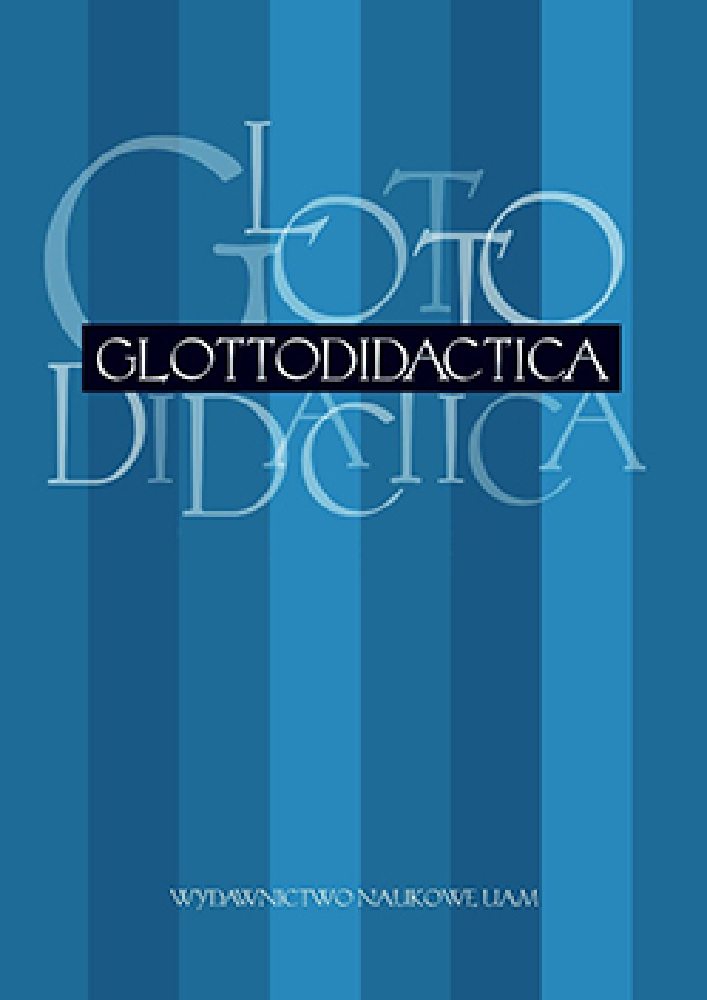Abstrakt
The subject for reflection in this paper is the translational challenge posed by the rendering of linguistic representations of national stereotypes, based on the example of the flower Edelweiss from the song Edelweiss which became a word-symbol for the inhabitants of the U.S.A. The translation of this stereotype created in the U.S.A., where the symbol of Edelweiss gained an added meaning, means that the translator of the English-German language pair is forced to explain the exo-cultural associations to those receivers who are enculturated in the country of this symbol’s origin.
Bibliografia
Bednarczyk, A. 2005. Wybory translatorskie. Modyfikacje tekstu literackiego w przekładzie i kontekst asocjacyjny. Łask: Oficyna Wydawnicza Leksem.
Berting, J., Villain-Gandossi, Ch. 1995. The role and significance of national stereotypes in international relations: An interdisciplinary approach. In: Walas, T. (ed.), Stereotypes and Nations. Kraków: International Cultural Centre, 13–27.
Diem, P. 1995. Die Symbole Österreichs. Zeit und Geschichte in Zeichen. Mit 300 Schwarzweiß- und Farbabbildungen. Wien: A&M.
Drügh, H. 2009. Overstanding Robert Wises The Sound of Music. Überlegungen zu Österreichs berühmtesten Film-Exilanten. In: Meurer, U., Oikonomou, M. (red.). Fremdbilder. Auswanderung und Exil im internationalen Kino, 87–106. (<http://www.transcript-verlag.de/ts1122/ts1122_1.pdf> . Date of access 25.09.2013)
Eliade, M. 1993. Sacrum, mit, historia. Wybór esejów. Warszawa: Wydawnictwo Naukowe PWN.
Głowiński, M. 1986. O intertekstualności. In: Pamiętnik Literacki, z. 4, 75–100.
Jung, C.G. 1976. Archetypy i symbole. Pisma wybrane. Warszawa: Wydawnictwo Czytelnik.
Kawiorski, S. 2014. Uwagi o przekładzie językowym. In: Podkarpackie Studia Biblioteczne, nr 3. http://psb.ur.edu.pl/sites/default/files/pdf/uwagi_o_przekladzie_jezykowym.pdf (Date of access 4.11.2016)
Majkiewicz, A. 2009. Intertekstualność jako nowe (stare) wyzwanie w teorii i praktyce przekładu literackiego. In: Rocznik Przekładoznawczy. Studia nad teorią, praktyką i dydaktyką przekładu. 5. http://apcz.pl/czasopisma/index.php/RP/article/viewFile/RP.2009.009/903 (date of access: 8.03.2016).
Meyer, H.F. 2008. Blutiges Edelweiss. Die 1. Gebirgs-Division im Zeiten Weltkrieg. Berlin: Ch. Links-Verlag.
Newmark, P. 1982. Approaches to Translation. Oxford: Pergamon Press.
Nord, Ch. 2015. Ausbildung der Ausbilder: Was man für die Übersetzungslehre wissen muss. In: Badstübner-Kizik, C., Fiśer, Z., Hauck, R. (Hrsg.). Übersetzungsvermittlung. Translatorisches Handeln. Neue Strategien. Didaktische Innovation. Frankfurt am Main–Berlin–Bern–Bruxelles–New York–Oxford–Wien: Peter Lang, 15–31.
Nycz, R., 1995. Tekstowy świat. Poststrukturalizm a wiedza a literaturze. Warszawa: Instytut Badań Literackich.
Rief, N. 2009. Sound Of Music: Der unbekannte Klang der Musik, http://diepresse.com/home/panorama/oesterreich/467493/Sound-Of-Music_Der-unbekannte-Klang-der-Musik (Date of access 5.09.2013).
Scheidegger, T. 2008. Mythos Edelweiss: zur Kulturgeschichte eines alpinen Symbols. Eine Dokumentation, Recherchiert und verfasst im Auftrag der Botanischen Gärten, (Date of access 25.09.2013).
Steiner, G. 2000. Po wieży Babel: problemy języka i przekładu. Kraków: Universitas.
Strasser, Ch. 2000. «The Sound of Music» – Ein unbekannter Welterfolg: die virtuelle Trapp-Emigrantensaga als globale Kultur-Ikone mit Widersprüchen. In: Kammerhofer-Aggermann, U., Keul, A.G. (ed.). The Sound of Music: zwischen Mythos und Marketing. Salzburger Beiträge zur Volkskunde 11. Salzburg: Salzburger Institut für Volkskunde, 267–302.
Tillich, P. 1994. Pytanie o nieuwarunkowane. Pisma z filozofii religii. Kraków: Wydawnictwo Znak.
Wang, M. 2013. An Analysis of Over-translation and Under-translation in Perspective of Cultural Connotation, <http://www.ier-institute.org/2070-1918/lnit17/v17/129.pdf> (Date of access 25.09.2013).
Walczak, A. 2011. O symbolu w kulturze i jego rozumieniu. Rozprawy filozoficzno-historyczne. In: Kultura i wychowanie, 1(1). <http://www.pedagogika.eu/kiw_01/artykuly/KiW_1_87-101.pdf> (Date of access 25.09.2013).
Licencja
Autorzy
Autorzy tekstów przyjętych do publikacji w czasopiśmie Glottodidactica są zobowiązani do wypełnienia, podpisania i odesłania na adres redakcji umowy o udzielenie nieodpłatnej licencji do utworów, z zobowiązaniem do udzielania sublicencji CC.
Zgodnie z umową, autorzy tekstów opublikowanych w czasopiśmie Glottodidactica udzielają Uniwersytetowi im. Adama Mickiewicza w Poznaniu niewyłącznej i nieodpłatnej licencji oraz zezwalą na użycie sublicencji Creative Commons Attribution-NoDerivatives 4.0 International (CC BY-ND 4.0).
Autorzy zachowują prawa do dalszego, swobodnego rozporządzania utworem.
Użytkownicy
Zainteresowani użytkownicy internetu uprawnieni są do korzystania z utworów opublikowanych od 2015 roku w Glottodidactica pod następującymi warunkami:
- uznanie autorstwa - obowiązek podania wraz z rozpowszechnionym utworem, informacji, o autorstwie, tytule, źródle (odnośniki do oryginalnego utworu, DOI) oraz samej licencji;
- bez tworzenia utworów zależnych - utwór musi być zachowany w oryginalnej postaci, nie można bez zgody twórcy rozpowszechniać np. tłumaczeń, opracowań.
Do wszystkich tekstów opublikowanych przed 2015 r. prawa autorskie są zastrzeżone.
Inne
Uniwersytet im. Adama Mickiewicza w Poznaniu zachowuje prawo do czasopisma jako całości (układ, forma graficzna, tytuł, projekt okładki, logo itp.).




